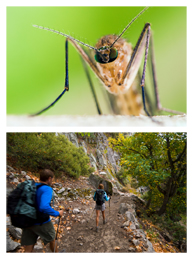
Citrefine International Ltd is a long time supporter of BADA, whose mission is to help educate people about the dangers of tick borne disease such as Lyme disease. Learn more here.
Ticks (Arachnida, Acari) are a group of around 800 species worldwide. Sheep and deer ticks are the most important vectors of diseases, transmitting Lyme disease and tickborne encephalitis as the most detrimental infections.
In North America and Europe the tick season lasts from May to November. In years with dry, hot weather the risk of infection is particularly high in May, June and September and less so in July and August.
Like mosquitoes, ticks transmit diseases while sucking blood, which is necessary for their development. Unlike mosquitoes, the tick usually needs several blood meals. To find a donor, it waits on blades of grass, ferns, bushes or on the undersides of leaves.
Stages of tick developments
When a tick locates a potential host, it attaches itself and looks for a suitable site to suck blood. In humans, it prefers to attach itself to warm, moist parts of the body such as the scalp, the armpits or the pubic region. The tick pierces the skin and starts to suck the blood. If undisturbed, it may continue to do so for up to nine days. When the tick has finished feeding, it drops to the ground and starts to develop eggs. It may now be several times its original size.
Tick bites are sometimes hard to detect because the victim barely feels the bite. The reason for this is that anaesthetic substances are secreted by the tick during the sucking process. A slight reddening of the skin around the wound may often be the only clue of a tick bite.
Tick borne pathogens are transmitted with the saliva, or sometimes with the tick excrement. Signs and symptoms of tick transmitted diseases in humans may take weeks or months to develop and are rather unspecific. This explains why it took until 1970 before a connection was established between Lyme disease and the bites of deer ticks (lxodes scapularis) and between summer encephalitis (FSME) and the bites of sheep ticks (lxodes ricinus).

